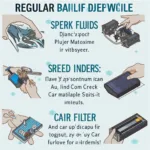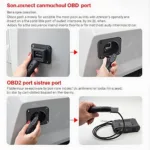Using an OBD2 diagnostic interface can feel intimidating if you’re not familiar with it. However, these handy devices are surprisingly simple to operate and can empower you to understand your vehicle’s health, potentially saving you time and money on mechanic visits. This guide will walk you through how to use an OBD2 diagnostic interface, from connecting it to interpreting the codes it retrieves.
Understanding the OBD2 Port and Interface
The OBD2 port, typically located under the dashboard on the driver’s side, is the gateway to your car’s computer. Your OBD2 diagnostic interface, whether a basic code reader or a sophisticated scan tool, plugs into this port and communicates with the vehicle’s electronic control units (ECUs). These interfaces come in various forms, from handheld devices to those that connect to your smartphone via Bluetooth or Wi-Fi.
Connecting the OBD2 Interface
Connecting your interface is straightforward. First, locate your OBD2 port. Then, with the ignition off, plug the interface firmly into the port. Ensure a secure connection. Next, turn the ignition key to the “on” position, without starting the engine. This powers up the interface and allows it to communicate with the car’s systems. 16 pin connector obd2 are standardized, making the connection process universally simple.
Reading and Interpreting Diagnostic Trouble Codes (DTCs)
Once connected and powered, your OBD2 diagnostic interface will be ready to read DTCs. Depending on your interface, this may involve pressing a button or initiating a scan through a software application on your phone or computer. The interface will then retrieve any stored DTCs, which are alphanumeric codes representing specific issues within your vehicle.
Interpreting these codes is crucial. While some interfaces provide brief descriptions of the codes, a comprehensive repair manual or online database is essential for a full understanding. These resources will provide detailed explanations of each code, including possible causes, symptoms, and diagnostic procedures. Don’t panic if you see a code; many are minor and easily addressed. However, some DTCs indicate serious issues requiring professional attention. obd2 connection triangle can be helpful in understanding the flow of information between the vehicle, the interface, and your diagnostic software.
Beyond Basic Code Reading: Advanced Features
Many OBD2 diagnostic interfaces offer more than just code reading. Some provide real-time data on various vehicle parameters, such as engine speed, coolant temperature, and fuel pressure. This data can be incredibly valuable for monitoring performance, diagnosing intermittent problems, and understanding how your car functions. Certain interfaces even allow you to perform specific tests, such as activating solenoids or resetting adaptive values. nissan infiniti obd2 scanner tool n607 offer specialized functionalities for specific car makes and models.
Choosing the Right OBD2 Interface
The right interface for you depends on your needs and budget. Basic code readers are affordable and sufficient for checking and clearing codes. However, if you want more advanced features, like real-time data monitoring, consider investing in a more sophisticated scan tool. Smartphone-based interfaces offer a good balance of affordability and functionality. torque pro android obd2 scanner is a popular example, offering a wide range of features through a user-friendly app. scanner automotriz interface elm327 usb can obd2 obdii offer various connectivity options.
Conclusion
Learning how to use an OBD2 diagnostic interface is a valuable skill for any car owner. It provides insight into your vehicle’s health, empowering you to address issues proactively and potentially save money. From simple code reading to advanced data analysis, these tools put you in control of your car’s maintenance. With a little practice, you’ll be able to confidently use your OBD2 diagnostic interface to keep your car running smoothly.
FAQ
-
What does OBD2 stand for? OBD2 stands for On-Board Diagnostics, Generation Two.
-
Where can I find my OBD2 port? The OBD2 port is typically located under the dashboard on the driver’s side.
-
What if my scanner doesn’t recognize my car? Ensure the ignition is in the “on” position and that the interface is securely connected. If issues persist, consult your interface’s manual or contact the manufacturer.
-
Can I clear DTCs with an OBD2 interface? Yes, most OBD2 interfaces allow you to clear DTCs. However, clearing the codes doesn’t fix the underlying problem; it simply removes the code from the ECU’s memory.
-
Are all OBD2 interfaces the same? No, OBD2 interfaces range from basic code readers to advanced scan tools with various features and functionalities.
Scenarios
-
Check Engine Light On: Use your OBD2 interface to retrieve the DTC and identify the issue.
-
Monitoring Vehicle Performance: Use real-time data monitoring to track parameters like engine speed and coolant temperature.
-
Pre-Purchase Inspection: Use an OBD2 interface to check for hidden problems before buying a used car.
For further reading, explore our articles on the 16 pin connector obd2 and obd2 connection triangle.
Need help? Contact us via WhatsApp: +1(641)206-8880, Email: [email protected] or visit us at 789 Elm Street, San Francisco, CA 94102, USA. We offer 24/7 customer support.

